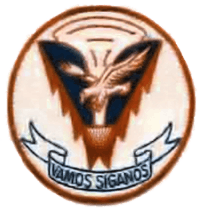830th Bombardment Squadron
| 830th Bombardment Squadron | |
|---|---|
|
Emblem of the 830th Bombardment Squadron (USAF) | |
| Active | 1943-1966 |
| Country | United States |
| Branch | United States Air Force |
| Type | Bombardment |
| Motto(s) | Vamos Siganos (We are Going, Follow Us) |

The 830th Bombardment Squadron is an inactive United States Air Force unit. Its last assignment was with 509th Bombardment Wing stationed at Pease Air Force Base, New Hampshire.
History
Activated as a B-24 Liberator heavy bombardment squadron in 1943; assigned to II Bomber Command for training in B-24 Liberators. Primarily trained in Nebraska and received deployment orders for the Mediterranean Theater of Operations (MTO) in March 1944.
Deployed to Southern Italy in April 1944; entered combat in May 1944, being assigned to Fifteenth Air Force. Engaged in very long range strategic bombing missions to enemy military, industrial and transportation targets in Italy, France, Germany, Austria, Hungary, Romania, and Yugoslavia, bombing marshalling yards, oil refineries, airdrome installations, heavy industry, and other strategic objectives. Also carried out some support and interdiction operations. Struck bridges, harbors, and troop concentrations in August 1944 to aid the invasion of Southern France. Hit communications lines and other targets during March and April 1945 to support the advance of British Eighth Army in northern Italy.
Returned to the United States in May 1945, being programmed for deployment to the Pacific Theater of Operations (PTO) as a B-29 Superfortress Very Heavy Bombardment Squadron. Many combat veterans of MTO demobilized upon arrival in the United States, and a small cadre of personnel reformed at Sioux Falls Army Airfield, South Dakota at the end of May. Reassigned to Second Air Force for training in Iowa, however Japanese Capitulation in August led to cancellation of deployment orders.
Assigned to 509th Composite Group in New Mexico as an atomic-capable Strategic Air Command bombardment squadron, equipped with Silverplate B-29 Superfortresses. Began upgrading to the new B-50 Superfortress, an advanced version of the B-29 in 1949. The B-50 gave the unit the capability to carry heavy loads of conventional weapons faster and farther as well as being designed for atomic bomb missions if necessary. Squadron deployed to SAC airfields in England, and also to Andersen AFB, Guam on long-term deployments in the 1950s.
By 1951, the emergence of the Soviet Mig-21 interceptor in the skies of North Korea signaled the end of the propeller-driven B-50 as a first-line strategic bomber. The squadron moved into the jet age when it received new, swept wing B-47 Stratojets in 1955 which were designed to carry nuclear weapons and to penetrate Soviet air defenses with its high operational ceiling and near supersonic speed. The squadron flew the B-47 for about a decade when by the mid-1960s it had become obsolete and vulnerable to new Soviet air defenses. The squadron began to send its stratojets to AMARC at Davis-Monthan AFB for retirement in 1965, and the unit inactivated in 1966.
Lineage
- Constituted 830th Bombardment Squadron (Heavy) on 14 September 1943
- Activated on 20 September 1943
- Redesignated 830th Bombardment Squadron (Very Heavy) on 5 August 1945
- Redesignated 830th Bombardment Squadron (Medium) on 2 July 1948
- Inactivated on 25 June 1966
Assignments
- 485th Bombardment Group, 20 September 1943
- 509th Composite (later Bombardment) Group, 6 May 1946
- 509th Bombardment Wing, 16 June 1952-25 June 1966
Stations
- Fairmont Army Airfield, Nebraska, 20 November 1943-11 March 1944
- Venosa Airfield, Italy, c. 30 April 1944-c. 9 May 1945
- Sioux Falls Army Air Field, South Dakota, 30 May 1945
- Sioux City Army Air Base, Iowa, 24 July 1945
- Smoky Hill Army Airfield Kansas, 8 September 1945
- Roswell Army Airfield (Later Walker AFB), New Mexico, 23 June 1946
- Pease AFB, New Hampshire, 1 July 1958-25 June 1966
Aircraft
- B-24 Liberator, 1943–1945
- B-29 Superfortress, 1945–1952
- B-50 Superfortress, 1951–1955
- B-47 Stratojet, 1955–1966
References
![]() This article incorporates public domain material from the Air Force Historical Research Agency website http://www.afhra.af.mil/.
This article incorporates public domain material from the Air Force Historical Research Agency website http://www.afhra.af.mil/.
- Maurer, Maurer, ed. (1982) [1969]. Combat Squadrons of the Air Force, World War II (PDF) (reprint ed.). Washington, DC: Office of Air Force History. ISBN 0-405-12194-6. LCCN 70605402. OCLC 72556.


